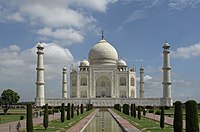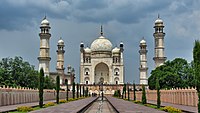User:Ssriram mt/sandbox
The Mughal dynasty was established after the victory of
Mughal architecture, a type of Indo-Islamic architecture developed during the 16th, 17th and 18th centuries throughout the ever-changing extent of their empire in the Indian subcontinent. It developed the styles of earlier Muslim dynasties in India as an amalgam of Islamic, Persian and Indian architecture. Mughal buildings have a uniform pattern of structure and character, including large bulbous domes, slender minarets at the corners, massive halls, large vaulted gateways, and delicate ornamentation; Examples of the style can be found in modern-day Afghanistan, Bangladesh, India and Pakistan.[1][2][3]
Precedents
Iltutmish was the first emperor to have a large tomb in the subcontinent.[4] Most of the tombs in Mughal Empire had marked influence from Iranian Timurid forms.[5] During the period of Lodis, there were hundreds of tombs built all across the empire. The tombs of nobles were bigger and elaborate than that of the royals. While the royal tombs were octagonal, the one of nobles were square in shape. The square shaped tombs were followed even during the Mughal tombs till 18th century. Sher Shah Suri at one time had the largest tomb in India built for himself at Sasaram.[6] The nine bays in the Mughal tombs in replicated from Timurid women house architecture. Babur in his memoir records the numerous memories in Timurid Herat, which inspired him to create the Mughal gardens.[7]
| Name of the Tomb | Name | year | Photo | Location | Built | Notes/Beliefs | |
|---|---|---|---|---|---|---|---|
| Gardens of Babur | Babur | 1483 - 1530 |  |
Kabul, Afghanistan34°30′11″N 69°09′29″E / 34.503°N 69.158°E | 1528 | The original construction date of the gardens ( Arguns he re-developed the site and used it as a guest house for special occasions, especially during the summer seasons. Since Babur had such a high rank, he would have been buried in a site that befitted him. The garden where it is believed Babur requested to be buried in is known as Bagh-e Babur. Mughal rulers saw this site as significant and aided in further development of the site and other tombs in Kabul. In an article written by the Aga Khan Historic Cities Programme,[8] describes the marble screen built around tombs by Mughal Emperor Shah Jahan in 1638.
| |
Humayun's tomb
|
Humayun | 1508-56 |  |
New Delhi, India28°35′35.8″N 77°15′02.5″E / 28.593278°N 77.250694°E | 1547 | The tomb was commissioned by Humayun's wife consort, Empress and the mother of his successor, the third Mughal emperor Akbar. Hamida Banu Begum (also known as Maryam Makani),[9][10][11][12][13][14][15] in 1558, and designed by Mirak Mirza Ghiyas and his son, Sayyid Muhammad,[16] Persian architects chosen by her. It was the first garden-tomb on the Indian subcontinent,[17] | |
| Akbar's tomb | Akbar | 1542 - 1605 |  |
Sikandra, Uttar Pradesh, India27°13′13.7″N 77°57′1.7″E / 27.220472°N 77.950472°E | 1605-13 | It was built in 1605–1613 by his son Jahangir and is situated in 119 acres of grounds in | |
| Tomb of Jahangir | Jehangir
|
1542 - 1605 |  |
Lahore, Pakistan31°37′21″N 74°18′12″E / 31.6225°N 74.3032°E | 1637 | The mausoleum dates from 1637, and is located in Rajauri on 28 October 1627. A funeral procession transferred his body from Kashmir and arrived in Lahore on Friday, 12 November 1627.[23]
| |
| Taj Mahal | Shah Jahan | 1592- 1666 |  |
Agra, India27°10′30″N 78°02′31″E / 27.17500°N 78.04194°E | 1632–53 | It was commissioned in 1632 by the crenellated wall. The Taj Mahal was designated as a UNESCO World Heritage Site in 1983 for being "the jewel of Muslim art in India and one of the universally admired masterpieces of the world's heritage". It is regarded by many as the best example of Mughal architecture and a symbol of India's rich history.[24][25]
| |
| Tomb of Aurangzeb | Aurangazeb
|
1618 - 1707 |  |
Ahmednagar, India20°0′18.13″N 75°11′29.04″E / 20.0050361°N 75.1914000°E | 1707 | In notable contrast to other Mughal tombs, which are large monuments of Mughal architecture, including the Taj Mahal, at his own direction Aurangzeb is buried in an unmarked grave[26] at the complex of the dargah or shrine of Sheikh Zainuddin.[27] It is located in the south-eastern corner of the complex of the dargah of Sheikh Zainuddin.[27] | |
| Bibi Ka Maqbara | Dilras Banu Begum | 1620-57 |  |
Aurangabad, Maharashtra, India19°54′05″N 75°19′13″E / 19.90151°N 75.320195°E | 1668-9 | It was commissioned in 1660 by the Mughal emperor Aurangzeb in the memory of his wife Dilras Banu Begum (posthumously known as Rabia-ud-Daurani) and is considered to be a symbol of Aurangzeb's 'conjugal fidelity'.[28][29][30] It bears a striking resemblance to the Taj Mahal, the mausoleum of Aurangzeb's mother, Mumtaz Mahal.[31]
| |
| Tomb of I'timād-ud-Daulah | Mirza Ghiyas Beg | 1576 - 1622 |  |
Agra, Uttar Pradesh, India27°11′33″N 78°01′55″E / 27.19250°N 78.03194°E | 1622-28 | Often described as a "jewel box", sometimes called the "Baby Taj", the tomb of I'timād-ud-Daulah is often regarded as a draft of the Sikandra – to its second phase, based on white marble and pietra dura inlay, most elegantly realized in the Taj Mahal. The mausoleum was commissioned by Nur Jahan, the wife of Jahangir, for her father Mirzā Ghiyās Beg, originally a Persian Amir in exile.[32]
| |
| Chausath Khamba | Mirza Aziz Koka | 1542 - 1624 |  |
New Delhi, India28°35′28.7″N 77°14′30.5″E / 28.591306°N 77.241806°E | 1623-24 | It is located in | |
| Chini Ka Rauza | Afzal Khan Shirazi | 1570 - 1639 |  |
Agra, India27°12′03″N 78°02′03″E / 27.20083°N 78.03417°E | 1635 | It is a funerary monument, Yamuna river in Agra, and 2 kilometres away from the Taj Mahal. The facade of the monument is also known its glazed tile work, called kashi or chini in Mughal era buildings.[36]
| |
| Ibrahim Rouza | Ibrahim Adil Shah II | 1580 - 1627 |  |
Bijapur, Karnataka, India16°49′41″N 75°42′03″E / 16.82813154794829°N 75.70081463693181°E | 1635 | It was built by Ibrahim Adil Shah which consists of his tomb and a mosque. It has a raising face to a common terrace, with a tank and fountain in between.[37] | |
| Khusro Bagh | Shah Begum, Khusrau Mirza , Nithar Begum
|
 |
Varanasi, Uttar Pradesh, India25°26′32″N 81°49′18″E / 25.4423°N 81.8216°E | 1622 | It is a large Indian Site of National Importance.[38]
|
* - Mughal Emperors.
Notes
- ^ Fatehpur Sikri was once a Jain pilgrimage centre: Book. 2013-02-27.
{{cite book}}:|work=ignored (help) - ^ "Excavation at Akbars fort at Fatehpur Sikri reveals flourishing Jain and Hindu habitation". Retrieved 2017-12-15.
- ^ "Fatehpur Sikri was once a Jain pilgrimage centre: Book". hindustantimes.com/. 2013-02-27. Retrieved 2017-12-15.
- ^ M 1992, p. 4
- ^ M 1992, p. 10
- ^ M 1992, p. 13-4
- ^ M 1992, p. 16-17
- ^ Aga Khan Historic Cities Programme, "Babur's Garden Rehabilitation Framework," (Kabul, Afghanistan: The Aga Khan Trust for Culture, 2004).
- ^ Annemarie Schimmel; Burzine K. Waghmar (2004). The Empire of the Great Mughals: History, Art and Culture. Reaktion Books. pp. 149.
- ^ Kamiya, Takeo. "Humayun's Tomb in Delhi". UNESCO. Retrieved 27 January 2017.
In 1565 the previous queen of the Mughal Dynasty, Haji Begum, ordered the construction of the largest and the most splendid mausoleum in the empire for her late ill-fated husband, Humayun, near to the Yamuna River.
- ^ Burke, S. M. (1989). Akbar, the Greatest Mogul. Munshiram Manoharlal Publishers. p. 191.
- ISBN 978-0143102625.
- Clarendon Press. p. 125.
- ISBN 978-0313305139.
- ^ "Mausoleum that Humayun never built". The Hindu. April 28, 2003. Archived from the original on December 6, 2007. Retrieved 31 January 2013.
- ^ "Humayun's Tomb". ArchNet. Retrieved April 23, 2018.
- ^ Humayun's Tomb, Delhi World Heritage Committee, UNESCO.
- ^ "Fascinating monuments, timeless tales". The Hindu. Chennai, India. 22 September 2003. Archived from the original on 29 October 2003.
- ^ Akbar's Tomb Archived 2010-06-19 at the Wayback Machine Archnet.org.
- ISBN 0-521-26728-5. p. 107.
- ^ Wiki Loves Monuments: Top 10 pictures from Pakistan are here!
- ^ "Tombs of Jahangir, Asif Khan and Akbari Sarai, Lahore". UNESCO World Heritage Centre. Retrieved 2013-12-03.
- ISBN 9780670083039. Retrieved 14 September 2017.
- ^ "Definition of Taj Mahal | Dictionary.com". www.dictionary.com. Retrieved 2021-03-01.
- ^ "Taj Mahal definition and meaning | Collins English Dictionary". www.collinsdictionary.com. Retrieved 2021-03-01.
- ISBN 9781598843378.
- ^ a b "Tomb of Aurangzeb" (PDF). Archaeological Survey of India, Aurangabad. Archived from the original (PDF) on 9 June 2020. Retrieved 20 March 2015.
- ISBN 9780226467672.
- ^ Eraly, Abraham (2008). The Mughal world: India's tainted paradise. Weidenfeld & Nicolson. p. 376.
- ^ "The Taj of Deccan". Deccan Herald. 19 February 2011.
- ^ Gopal, Madan (1990). K.S. Gautam (ed.). India through the ages. Publication Division, Ministry of Information and Broadcasting, Government of India. p. 174.
- ISBN 9788174369420.
- ^ "Mirza 'Aziz Kotaltash Tomb". ArchNet Digital Library. Archived from the original on 2012-05-03. Retrieved 2009-04-10.
- ISBN 978-0-521-26728-1. Retrieved 2009-04-10.
- ^ "Chausath Khambhaaccess". Delhilive.com. 2007-03-21. Archived from the original on 2008-11-21.
- ISBN 978-81-7156-551-1.
- ISBN 9781783107834.
- ^ "Elegant tombs, unkempt greens". The Hindu. 22 September 2012.
References
- Asher, Catherine Blanshard; Asher, Catherine Ella Blanshard; Asher, Catherine B.; Johnson, Gordon (1992). Architecture of Mughal India Volume 4. Cambridge University Press.
